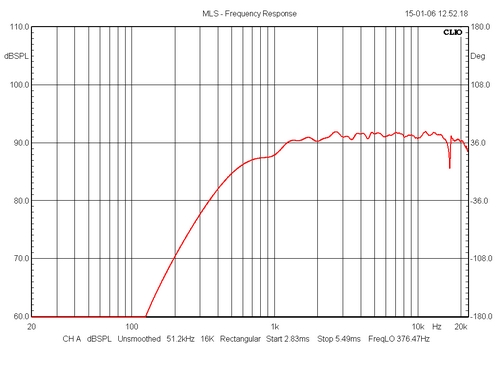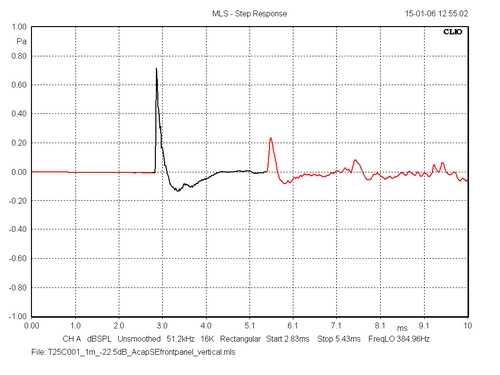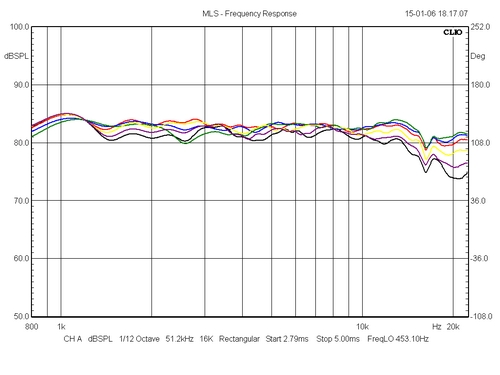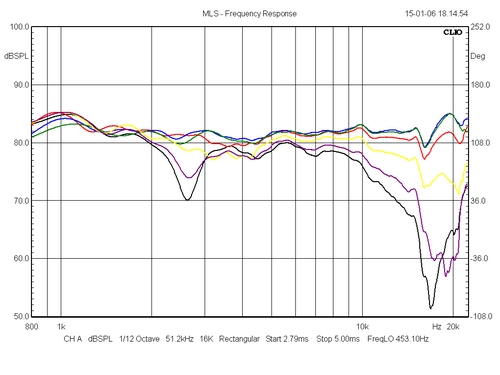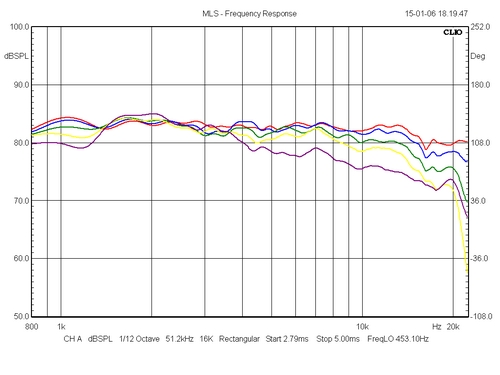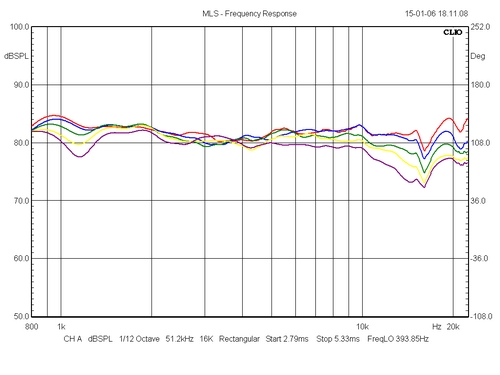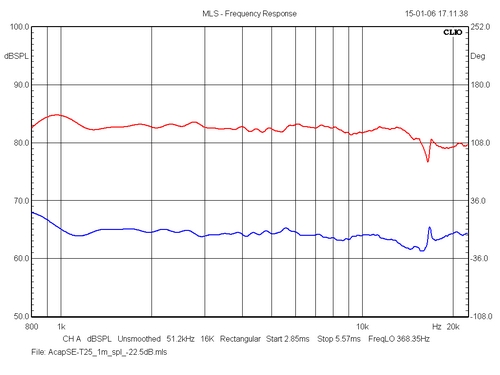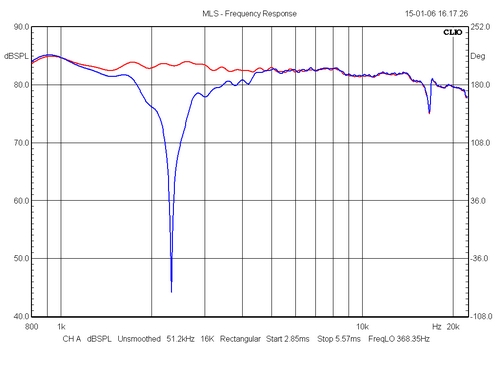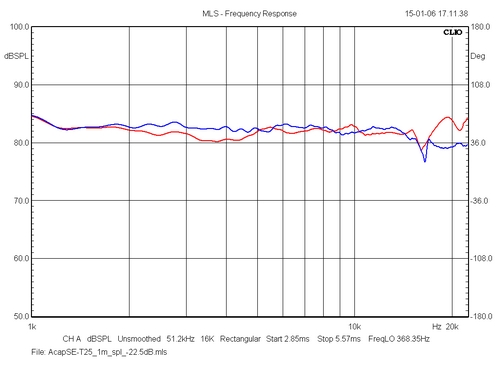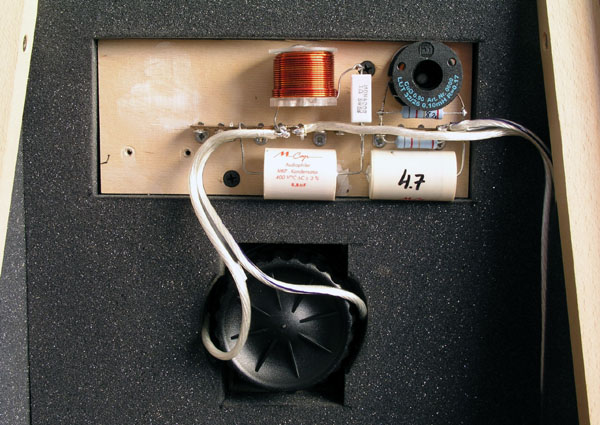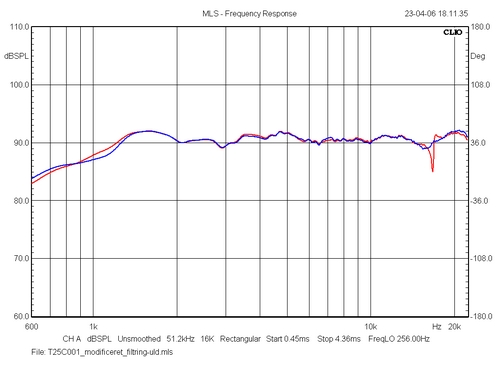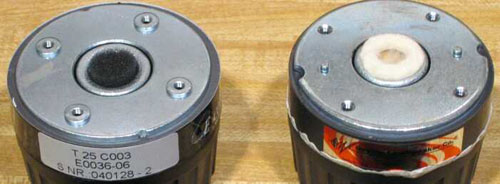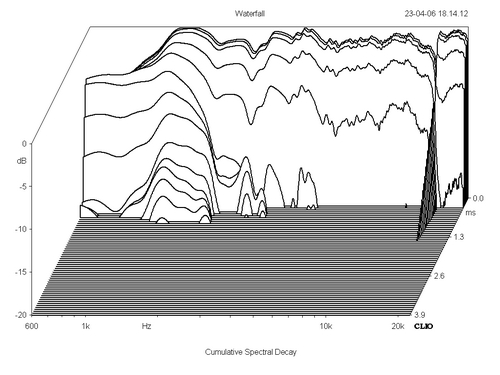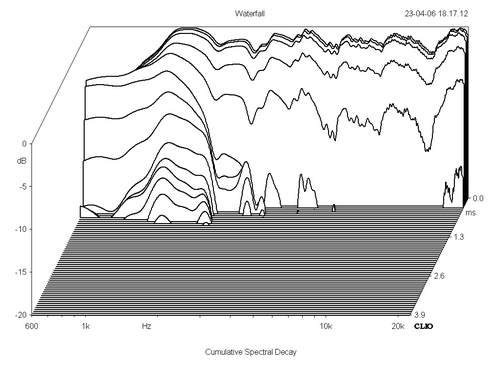|
Acapella SEas
Copyright 2006 © Troels Gravesen
Open kit, not supported by Jantzen Audio. The New Tweeter Crossover Measurements
|
Fooling around with the Aurum Cantus G2Si ribbons and the SEAS T25C001 dome tweeters, it appeared that these drivers have exactly the same faceplate diameters. The Acapella SE ribbon rebates were initially routed for 6 mm depth for the Fountek JP3 ribbons and the T25C001 having a 6.3 mm thick faceplate fits nicely into here. So, a little rounding of the hole for the magnet and in went the SEAS tweeters. An all-SEAS set-up, thus the Acapella SEas name! The rationale behind this
experiment is to be read in the TJL file. On the agenda
here is power response and to cut a long story short, the
ribbons have reduced vertical dispersion and the domes
don't. So, what would happen to the Acapella SE if I put
in a dome? download Acapella cabinet drawings, zip file
Left: SEAS EXCEL tweeters, T25C001. I had
these excellent tweeters for half price from a shop in
Copenhagen (sorry, sold out) and it carries a rather
rigid diaphragm made from Sonotex (whatever that is) and
the surround looks like some plastic material. Whatever,
the face plate is one heavy chunk of metal and the
overall finish is nothing short of excellent. This
tweeter has no ferrofluid. The T25C001 is available from
a number of dealers despite not present in the newly
updated SEAS list of
tweeters. I'm pretty sure a T25CF001 (F for ferro
fluid) will do the same as these - and you can always
remove the ferro fluid if you don't like it. And the
T25C003 has the same "E0036" number as the
T25C001. I wish SEAS would tell what's going on. Tweeter performance:
Left: T25 response from Acapella front panel with no crossover attached. Now this is some nice response! The T25 has a strange dip at 16-17 kHz. Not present from the SEAS measurements, but it can be seen here at: http://ldsg.snippets.org/graphics/seas/e006w.gif Right: T25 step response. Nice! Vertical dispersion
Left: Acapella SEas vertical dispersion at
1 metre distance. Red = tweeter height, blue = +10 cm,
green = +20 cm, yellow = -10 cm, purple = -20 cm. (+ =
up, - = down) Horizontal dispersion:
Left: Horizontal dispersion with T25 tweeter. Red = on-axis, red = 10 deg., blue = 20 deg., green = 30 deg., yellow = 40 deg., purple = 50 deg. Right: Horizontal dispersion with Aurum Cantus ribbon: Red = on-axis, red = 10 deg., blue = 20 deg., green = 30 deg., yellow = 40 deg., purple = 50 deg. Actually the ribbon is doing better at 50 deg. compared to the T25, extreme even dispersion up to 10 kHz. Final performance, Acapella SEas
Left: Frequency response at 1 metre
distance. Red = SPL, blue = minimum phase. Before and after -
Before and after: Red is the Acapella SE and blue is the Acapella SEas. The SEas version for sure is linear. It's difficult to change only one thing at a time when dealing with tweeter replacement. What we hear is not only the intrinsic qualities of the new "thing" but also the impact on overall performance from a changed crossover and changed SPL amplitude. And there are some differences here. The 2-5 kHz region has a lift of 1-2 dB lift, and I'm sure this counts for some of the sonic differences. 1-2 dB is a lot and would the ribbon solution sound the same from this change? Probably some, but it wouldn't make the same off-axis performance as seen from the T25. Normally I wouldn't voice a speaker this flat, but here it goes well and probably due to the mid having an overall higher power response being a dipole. What we see here is on-axis; what we hear is this plus all room reflections.
A cure for a minor tweeter "problem":
On of my friends made me aware of a website describing a cure for the tweeter resonance at 17-18 kHz. A felt ring on top of the centre polepiece. Simple as that. Pole-Piece Vent Felt Tweak - Seas T25C003 Tweeter (2). Thanks to Dave at Dave's Speaker Pages.
Picture is from Dave's website. No need to show mine. I used some 3 mm self-adhesive felt material that was cut to approx. 1.5 mm height and with a pair of scissors I cut the ring. I also replaced the polyester plug with some loose wool felt material.
Left: CSD of T25 tweeter before modification. Right: CSD of T25 tweeter after modification. |


